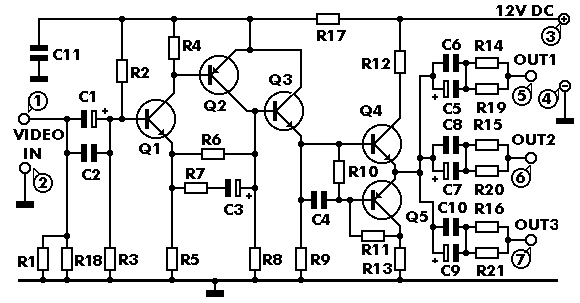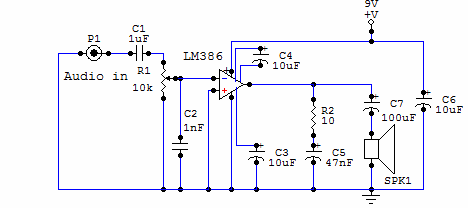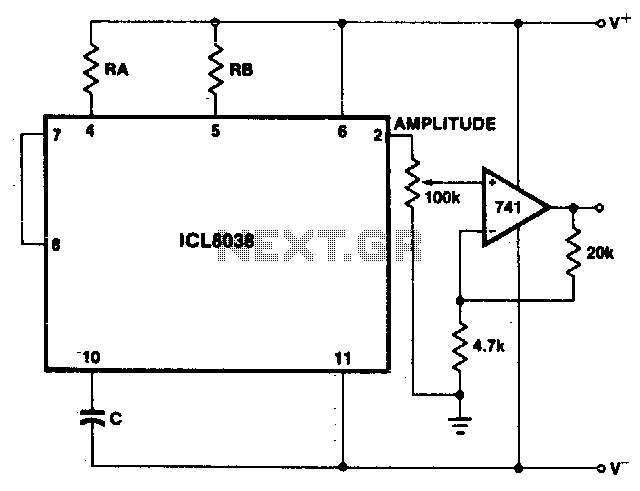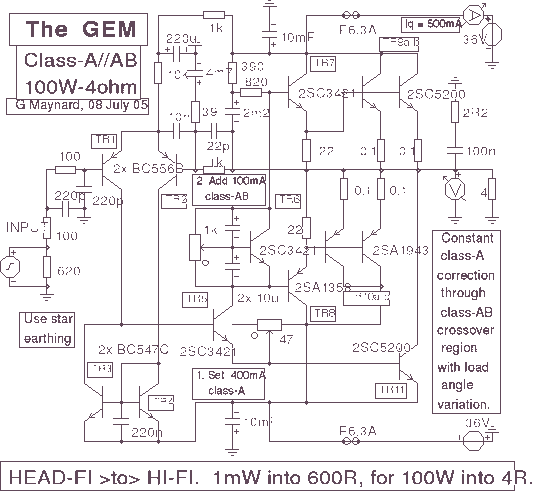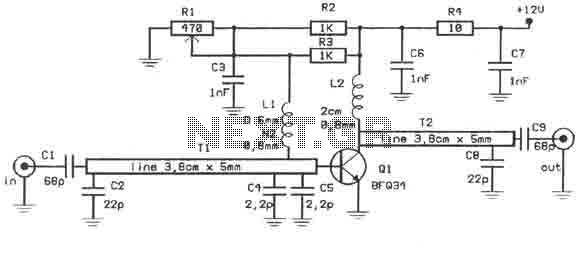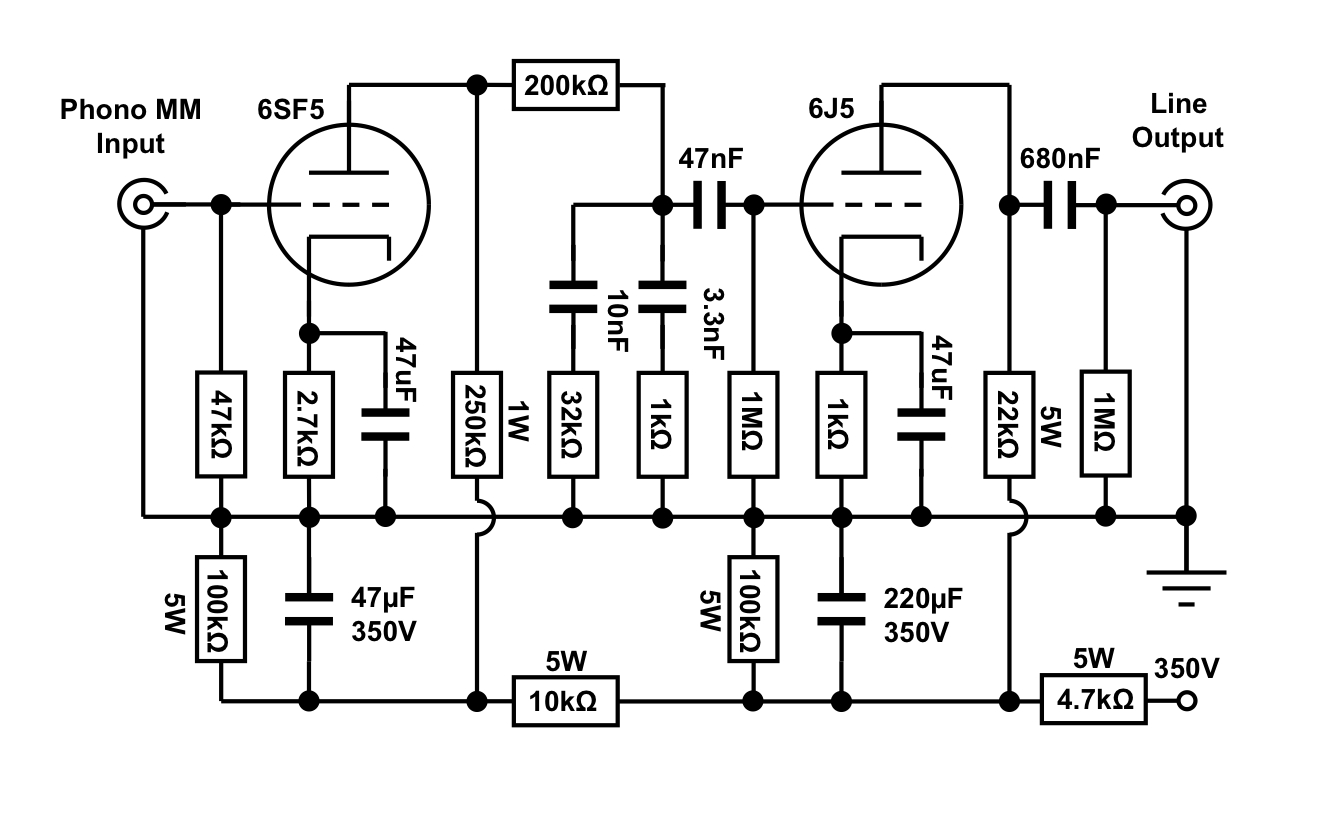
guitar amplifier
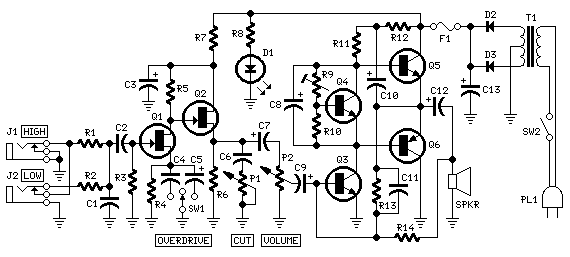
The objective of this design is to create a Combo amplifier that is reminiscent of those commonly found in the 1960s and 1970s. It is particularly effective as a guitar amplifier but is also suitable for various electronic musical instruments or microphones. A power output of 5W was a standard feature of these popular devices, attributed to the widespread use of a class A single-tube output stage, as exemplified by the Vox AC-4 model. Additionally, the current circuit can achieve 10W of output power when connected to an 8 Ohm load, or approximately 18W at 4 Ohm. It incorporates a two-FET preamplifier, two inputs with varying sensitivity, a treble-cut control, and an optional switch for overdrive or enhanced treble. The technical specifications are impressive for such a straightforward design: when utilizing Darlington transistors as output devices, it is crucial for the sensing transistor (Q4) to maintain close thermal contact with the output transistors. Consequently, a TO126-case transistor type was selected for its ease of mounting on the heatsink, positioned in proximity to the output pair.
The Combo amplifier design outlined is a versatile and nostalgic representation of vintage amplification technology. The use of a class A single-tube output stage not only provides a warm and rich sound characteristic of that era but also ensures a simple yet effective amplification method. The amplifier's ability to deliver 10W at 8 Ohms and 18W at 4 Ohms makes it suitable for various applications, from home practice to small gigs, catering to the needs of musicians who require portability without sacrificing sound quality.
The two-FET preamplifier is a notable feature, enhancing the amplifier's input sensitivity and allowing for a broader range of sound dynamics. The presence of two inputs with different sensitivity levels enables the connection of both high-output instruments, such as electric guitars, and lower-output devices, such as microphones, making it adaptable for diverse musical setups. The inclusion of a treble-cut control allows users to tailor the tonal quality of the output, catering to personal preferences or specific musical styles.
The optional switch for overdrive or treble enhancement provides additional versatility, allowing musicians to achieve a more aggressive sound when needed. This feature is particularly beneficial in genres where distortion is desired, such as rock or blues, offering a modern twist to the vintage amplifier design.
Thermal management is a critical aspect of this amplifier's design, especially when utilizing Darlington transistors, which are known for their high current gain but can generate significant heat. By ensuring that the sensing transistor (Q4) is thermally coupled to the output transistors, the design minimizes the risk of thermal runaway, thereby enhancing reliability and performance. The choice of a TO126-case transistor facilitates this thermal coupling, ensuring efficient heat dissipation and maintaining optimal operating temperatures.
Overall, this Combo amplifier design effectively combines vintage aesthetics with modern functionality, making it an excellent choice for musicians seeking a reliable and versatile amplification solution.The aim of this design is to reproduce a Combo amplifier of the type very common in the `sixties and the `seventies of the past century. It is well suited as a guitar amplifier but it will do a good job with any kind of electronic musical instrument or microphone.
5W power output was a common feature of these widespread devices due to the general adoption of a class A single-tube output stage (see the Vox AC-4 model). Furthermore, nowadays we can do without the old-fashioned Vib-Trem feature frequently included in those designs. The present circuit can deliver 10W of output power when driving an 8 Ohm load, or about 18W @ 4 Ohm.
It also features a two-FET preamplifier, two inputs with different sensitivity, a treble-cut control and an optional switch allowing overdrive or powerful treble-enhancement. Technical data are quite impressive for so simple a design: In all cases where Darlington transistors are used as the output devices it is essential that the sensing transistor (Q4) should be in as close thermal contact with the output transistors as possible.
Therefore a TO126-case transistor type was chosen for easy bolting on the heatsink, very close to the output pair. 🔗 External reference
The Combo amplifier design outlined is a versatile and nostalgic representation of vintage amplification technology. The use of a class A single-tube output stage not only provides a warm and rich sound characteristic of that era but also ensures a simple yet effective amplification method. The amplifier's ability to deliver 10W at 8 Ohms and 18W at 4 Ohms makes it suitable for various applications, from home practice to small gigs, catering to the needs of musicians who require portability without sacrificing sound quality.
The two-FET preamplifier is a notable feature, enhancing the amplifier's input sensitivity and allowing for a broader range of sound dynamics. The presence of two inputs with different sensitivity levels enables the connection of both high-output instruments, such as electric guitars, and lower-output devices, such as microphones, making it adaptable for diverse musical setups. The inclusion of a treble-cut control allows users to tailor the tonal quality of the output, catering to personal preferences or specific musical styles.
The optional switch for overdrive or treble enhancement provides additional versatility, allowing musicians to achieve a more aggressive sound when needed. This feature is particularly beneficial in genres where distortion is desired, such as rock or blues, offering a modern twist to the vintage amplifier design.
Thermal management is a critical aspect of this amplifier's design, especially when utilizing Darlington transistors, which are known for their high current gain but can generate significant heat. By ensuring that the sensing transistor (Q4) is thermally coupled to the output transistors, the design minimizes the risk of thermal runaway, thereby enhancing reliability and performance. The choice of a TO126-case transistor facilitates this thermal coupling, ensuring efficient heat dissipation and maintaining optimal operating temperatures.
Overall, this Combo amplifier design effectively combines vintage aesthetics with modern functionality, making it an excellent choice for musicians seeking a reliable and versatile amplification solution.The aim of this design is to reproduce a Combo amplifier of the type very common in the `sixties and the `seventies of the past century. It is well suited as a guitar amplifier but it will do a good job with any kind of electronic musical instrument or microphone.
5W power output was a common feature of these widespread devices due to the general adoption of a class A single-tube output stage (see the Vox AC-4 model). Furthermore, nowadays we can do without the old-fashioned Vib-Trem feature frequently included in those designs. The present circuit can deliver 10W of output power when driving an 8 Ohm load, or about 18W @ 4 Ohm.
It also features a two-FET preamplifier, two inputs with different sensitivity, a treble-cut control and an optional switch allowing overdrive or powerful treble-enhancement. Technical data are quite impressive for so simple a design: In all cases where Darlington transistors are used as the output devices it is essential that the sensing transistor (Q4) should be in as close thermal contact with the output transistors as possible.
Therefore a TO126-case transistor type was chosen for easy bolting on the heatsink, very close to the output pair. 🔗 External reference
